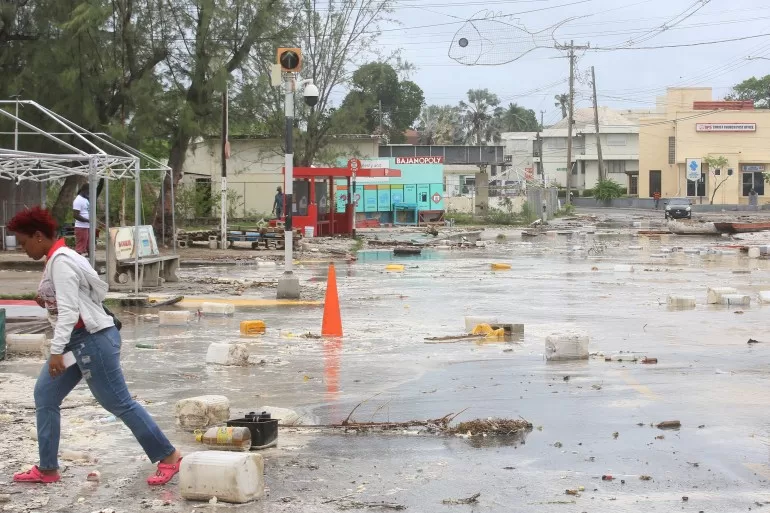The hurricane, which has been designated the highest category for storms – Category 5, has already claimed its first victim – one death has been reported on Union Island – while most homes in Grenada, where winds reached 240km/h (150mph), have been damaged or destroyed. Among the worst affected are the islands of Carriacou and Petite Martinique in Grenada.
According to the US National Hurricane Center’s (NHC) latest public advisory, Beryl is “expected to bring life-threatening winds and storm surge to Jamaica”.
This is one of the most powerful hurricanes to hit the region since Hurricane Maria in 2017, also a Category 5 storm, which hit Dominica, Puerto Rico, the US Virgin Islands and other parts of the Caribbean with devastating consequences. The estimated death toll was 3,059, with 2,975 of those deaths occurring in Puerto Rico alone.
Here’s what we know about Hurricane Beryl so far.

How serious is Hurricane Beryl?
Beryl is the first recorded Atlantic storm to move from Category 1 to Category 5 this early in the hurricane season, which typically runs from the beginning of June to late November. Beyond Grenada, reports say Beryl has reached wind speeds of 270km/h (165 mph).
In a news briefing on Monday, Grenada Prime Minister Dickon Mitchell said, “In half an hour, Carriacou was flattened.” Carriacou is the second-largest island within the state of Grenada.
The US National Hurricane Center (NHC) stated, “This is an extremely dangerous and life-threatening situation.”

Where will the hurricane hit?
Hurricane warnings are in effect for Barbados, where Beryl also passed by on Monday, Grenada, Tobago and St Vincent with tropical storm warnings for Martinique, St Lucia and Trinidad. Grenada is in an extended state of emergency with rainfall of as much as 12 inches (30.5cm) expected in some places.
According to local news, the island of St Lucia, south of Grenada, has experienced downed power lines, blocked roads, scattered tree branches and other debris.
The Dominican Republic and Haiti, where rainfall could reach six inches (15.2cm), have been placed under storm warnings.
In an X post on Monday from the NHC, the centre reported a tropical storm warning had also been issued for the south coast of Hispaniola.
5pm AST July 1st — Latest Key Messages for Hurricane #Beryl. Should remain a powerful hurricane as it moves across the Caribbean Sea this week. A Tropical Storm Warning is in effect for the southern coast of Hispaniola & Hurricane Watch is in effect for Jamaica.
Full advisory… pic.twitter.com/v6Z2D4bNXX
— National Hurricane Center (@NHC_Atlantic) July 1, 2024
On Tuesday morning, Beryl was 1,120km (695 miles) east-southeast of Kingston, Jamaica with sustained winds of 270km/h (165mph), according to the NHC. It is moving quickly in a west-northwesterly direction.
The hurricane is expected to hit Jamaica on Wednesday and the Cayman Islands on Thursday.
The southeastern Caribbean had not witnessed a hurricane this powerful since Hurricane Ivan, classed as a Category 3 storm, inflicted severe damage in 2004.
What do the different storm categories mean?
According to the US Navy, there are five categories of hurricanes.
- Category 1: Sustained winds of 74 to 95mph (119-153km/h).
- Category 2: Sustained winds of 96 to 110mph (154-177km/h).
- Category 3: Sustained winds of 111 to 130mph (178-209km/h).
- Category 4: Sustained winds of 131 to 155mph (210-249km/h).
- Category 5: Winds greater than 155 mph (greater than 249km/h).
In an “Ask a NASA Scientist” video posted by the space centre, Mara Cordero-Fuentes, NASA Atmospheric Scientist, said: “When you say, “Are hurricanes getting stronger?” in the sense of, “Are they going to be category 6″, The answer in that case will be no. Because of physics, hurricanes do not reach more than a Category 5.”
Are hurricanes getting stronger?
Yes. In her “Ask a NASA scientist” post, Cordero-Fuentes said: “We do see more and more hurricanes in the Atlantic every season getting to Category 3, Category 4 or Category 5 compared to seasons 40 years ago.”
In October 2022, a study of tropical cyclones (TCs – another term for hurricanes and typhoons) by Scientific Reports, a peer-reviewed open-access scientific journal published by Nature Portfolio, found an increase in the frequency of cyclones.
The study stated, “The overall frequency and magnitude of quickly intensifying TC events have already increased for the Atlantic basin as the planet and our oceans have warmed over the past 50 years. Furthermore, the locations at which such intensification events occur have also varied.”
What’s the difference between a hurricane, typhoon and a cyclone?
Surprisingly hurricanes, cyclones and typhoon are roughly the same. They are all tropical storm weather systems which can have a destructive effect, but the labels are used to differentiate them by geolocation.
In the North Atlantic and Northeast Pacific oceans, the label “hurricane” is used. In the Northwest Pacific Ocean, the term “typhoon” is used. Lastly, the cyclone label is used in the South Pacific and Indian oceans.
These storms are powerful, spinning weather systems with low-pressure areas, warm ocean waters, and strong winds, spanning several hundreds of miles, often leading to heavy rainfall and potential coastal flooding.
Why are some areas more susceptible than others
There are a multitude of factors but here are the three main ones:
- Location: Hurricanes typically form in tropical and subtropical regions with many Caribbean countries. Most hurricanes typically form in the Atlantic Ocean and then travel west. Many Caribbean countries are at risk as their location is in the path of moving hurricanes. The places with the most hurricanes are Cuba, Madagascar, Vietnam, Taiwan, Australia, the US, Mexico, Japan, the Philippines and China.
- Currents: Warm water is crucial for the formation and maintenance of hurricanes. For a hurricane to form sea surface temperatures need to be 26.5 degrees Celsius (79.7F) over a depth of 50 meters (164 feet).
- The wind: As wind shear (direction, speed and height) changes, this can help a hurricane become stronger by allowing warm air to rise and fuel the storm.
